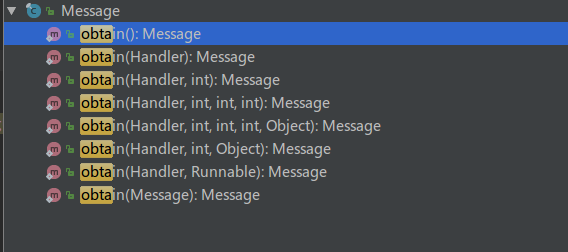相关类介绍
先来看下相关类在源码中的注释。
Handler
Handler类注释:Handler可以向与线程关联的MessageQueue中发送Message及Runnable对象,并可以处对这些Message及Runnable对象进行处理.每一个Handler都和一个线程以及该线程的MessageQueue关联。当创建一个Handler时,该Handler就会和创建该Handler的线程MessageQueue绑定–之后Handler将传递Message和runnable objects给该MessageQueue,并在它们从消息队列出队时处理它们。
Handler有两个作用:安排Message和runnables在将来某个点执行(延时执行);将一个action入队到自己所有的另一个线程进行执行(线程切换)。
分发消息可以通过以下几个方法完成:
- post(Runnable),//Runnable
- postAtTime(Runnable, long),
- postDelayed(Runnable, long),
- sendEmptyMessage(int), //Message
- sendMessage(Message),
- sendMessageAtTime(Message, long),
- sendMessageDelayed(Message, long)
post系列的方法用于enqueue runnables,setMessage系列的方法用来传递Message,Message可以通过Bundle传递数据,接收到Message后通过handleMessage方法进行处理。
在传递Message和Runnable时,可以选择在MessageQueue准备好后马上执行或者延时一定时间或者在某个时间点进行执行,后两者可以用来实现timeouts,ticks以及其他基于时间的行为。
应用的进程被创建后,主线程会维护一个消息队列用于管理顶层的应用对象(activities,broadcast receivers等)以及应用它们创建的所有窗口。可以创建自己的线程,通过Handler反过来和主线程进行沟通(post或者send),发送的Message和runnable对象在主线程的handler中进行调度,并在合适的时机进行处理。
Message
Message包含向Handler发送的描述信息和任意的数据对象,主要包含两个整数字段和一个额外的对象字段(不需要强制类型转换)。
在构造Message对象时,最好的方法是通过Message的obtain()方法或者Handler的obtainMessage()方法,两者的区别在于后者会自动设置Message的target为调用的Handler。
MessageQueue
用于保存待Looper分发的message列表的底层类。Message不是直接添加到MessageQueue中的,而是通过与Looper关联的Handler进行添加。
可以通过Looper#myQueue()方法获取当前线程的消息列表。
Looper
用于进行线程的消息循环。线程默认没有关联的Looper,要创建Looper可以通过调用Looper.prepare()和Looper.loop()。不过主线程例外,系统会为主线程创建Looper,该过程在ActivityThread的main方法中进行。常见的和message loop交互的方式是通过Handler类。
典型的Looper实现如下,通过Looper.prepare()和Looper.loop()初始化一个和Looper通信的Handler。
1
2
3
4
5
6
7
8
9
10
11
12class LooperThread extends Thread {
public Handler mHandler;
public void run() {
Looper.prepare();
mHandler = new Handler() {
public void handleMessage(Message msg) {
// process incoming messages here
}
};
Looper.loop();
}
}
Message获取
Message获取方式
前面说了Message的获取主要有两种方式:通过Handler的obtainMessage()系列方法或者通过Message的obtain()系列方法。先来看看Handler的obtainMessage()系列方法:
1
2
3
4
5
6
7
8
9/**
* Returns a new {@link android.os.Message Message} from the global message pool. More efficient than
* creating and allocating new instances. The retrieved message has its handler set to this instance (Message.target == this).
* If you don't want that facility, just call Message.obtain() instead.
*/
public final Message obtainMessage()
{
return Message.obtain(this);
}1
2
3
4public final Message obtainMessage(int what)
{
return Message.obtain(this, what);
}1
2
3
4public final Message obtainMessage(int what, Object obj)
{
return Message.obtain(this, what, obj);
}1
2
3
4public final Message obtainMessage(int what, int arg1, int arg2)
{
return Message.obtain(this, what, arg1, arg2);
}1
2
3
4public final Message obtainMessage(int what, int arg1, int arg2, Object obj)
{
return Message.obtain(this, what, arg1, arg2, obj);
}从注释上可知,其实Handler获取Message最终还是通过Message的相关方法,只不过除了从Message对象池获取Message外,还将本身设为了Message的target。下面来看下Message的相关方法。

1
2
3
4
5
6
7
8
9
10
11
12
13
14
15
16
17/**
* Return a new Message instance from the global pool. Allows us to
* avoid allocating new objects in many cases.
*/
public static Message obtain() {
synchronized (sPoolSync) {
if (sPool != null) {
Message m = sPool;
sPool = m.next;
m.next = null;
m.flags = 0; // clear in-use flag
sPoolSize--;
return m;
}
}
return new Message();
}上面这个方法是其他几个方法的基础,另外几个方法(上图中第2~6个重载方法)都是在该方法的基础上对得到的Message属性(即Message携带的数据)进行了赋值。比如下面的方法,除了获取Message对象外,还将该对象的target设为了参数handler。
1
2
3
4
5
6
7
8
9
10
11/**
* Same as {@link #obtain()}, but sets the value for the <em>target</em> member on the Message returned.
* @param h Handler to assign to the returned Message object's <em>target</em> member.
* @return A Message object from the global pool.
*/
public static Message obtain(Handler h) {
Message m = obtain();
m.target = h;
return m;
}而obtain(Message orig)生成新的Message并将orig的值复制到新的Message:
1
2
3
4
5
6
7
8
9
10
11
12
13
14
15
16
17
18
19
20
21
22/**
* Same as {@link #obtain()}, but copies the values of an existing
* message (including its target) into the new one.
* @param orig Original message to copy.
* @return A Message object from the global pool.
*/
public static Message obtain(Message orig) {
Message m = obtain();
m.what = orig.what;
m.arg1 = orig.arg1;
m.arg2 = orig.arg2;
m.obj = orig.obj;
m.replyTo = orig.replyTo;
m.sendingUid = orig.sendingUid;
if (orig.data != null) {
m.data = new Bundle(orig.data);
}
m.target = orig.target;
m.callback = orig.callback;
return m;
}另外有一个较特殊的一个重载方法:
1
2
3
4
5
6
7
8
9
10
11
12
13
14/**
* Same as {@link #obtain(Handler)}, but assigns a callback Runnable on
* the Message that is returned.
* @param h Handler to assign to the returned Message object's <em>target</em> member.
* @param callback Runnable that will execute when the message is handled.
* @return A Message object from the global pool.
*/
public static Message obtain(Handler h, Runnable callback) {
Message m = obtain();
m.target = h;
m.callback = callback;
return m;
}该方法除了Handler外还接收了一个Runnable参数,该对象在消息进行处理时会优先进行执行,详细的后面的消息处理部分会介绍。
Message对象池的维护
在上面看到Message对象池的时候一直有个疑问,Message对象池是怎么维护的?再来看一下Message#obtain()方法:
1
2
3
4
5
6
7
8
9
10
11
12
13
14
15
16
17/**
* Return a new Message instance from the global pool. Allows us to
* avoid allocating new objects in many cases.
*/
public static Message obtain() {
synchronized (sPoolSync) {
if (sPool != null) {
Message m = sPool;
sPool = m.next;
m.next = null;
m.flags = 0; // clear in-use flag
sPoolSize--;
return m;
}
}
return new Message();
}从上面的代码中可以看出来,Message采用了链表的结构,每次取对象时将链表头部的元素取出并将指针向前移动一位,同时清除返回对象的in-use标志。在sPool为空的情况下,也就是对象池中没有可用的对象是才会重新构造Message对象。Message的构造方法如下:
1
2
3
4/** Constructor (but the preferred way to get a Message is to call {@link #obtain() Message.obtain()}).
*/
public Message() {
}问题来了,开始的时候对象池为空,而且构造方法里什么也没做,那么构造的对象是怎么加入到对象池(链表)中的?查找一下引用sPool的地方:

对sPool进行修改的地方有两处,其中一处在obtain()方法中,这个排除,还有一处是在recycleUnchecked()方法中。
1 | /** |
可以看到,如果对象池没满,则调用该方法的Message对象会被放到链表的头部。
再来看一下上面的FLAG_IN_USE是干嘛的:
1 | /** If set message is in use. |
从注释来看,在Message被enqueue后该标志就会一直存在,直到新的Messge被创建或者Message重新被obtain,因为只有在此时(消息发出去之前)才允许修改Message内容。
总结一下这一部分。Message用在在不同线程之间发送消息,是Handler和Looper沟通的媒介,消息内容可以是简单的int类型,也可以时Object类型,也可以是复杂的Bundle类型。Message获取有两种方式:通过Handler或者通过Message。通过Handler获取Message会将自身设为Message的target,发送消息时采用Message的sendToTarget()方法即可;通过Message获取的对象根据参数的不同可以采用sendTotarget()或者Handler的sendMessage()方法进行发送。
消息发送过程
上面提到过,消息的发送也有两种方式,通过Message#sendTotarget()或者通过Handler的sendMessage()系列方法。Message#sendTotarget()代码如下:
1 | /** |
其实就是调用Handler的sendMessage(Message msg)方法。
Handler发送消息的方法有以下几种重载方式:

几个sendEmptyMessage……的方法其实在方法内部通过obtain方法获取了Message对象,然后设置该对象的what值,最后调用对应的sendMessage……方法。而sendMessage()、sendMessageDelayed()最终都是调用的sendMessageAtTime()方法。
1 | /** |
从注释可知,放入消息队列中的Message是按照传递的uptimeMillis进行排列的,sendMessageAtTime()传递的是发送消息时的时间加上延时的时间(不包括休眠时间),而另一个方法sendMessageAtFrontOfQueue()与之类似,不过传递的绝对时间为0,这回导致该消息被放置到消息队列的最前面。
1 | /** |
代码里提到该方法只有在特殊情况下才能使用,否则容易产生负面影响,具体用法尚不明确(用来插队的?)。
消息入队
消息发送后最终都会通过Handler#enqueueMessage()方法将消息进行入队,该方法实现如下:
1 | private boolean enqueueMessage(MessageQueue queue, Message msg, long uptimeMillis) { |
可以看到,通过哪种方式获取Message对象,最终都会设置该Message的target。消息的异步与否先不去管,继续往下追代码,之后就进入到了MessageQueue的enqueueMessage()方法:
1 | boolean enqueueMessage(Message msg, long when) { |
从上面可以看到,如果队列为空传递过来的时间为0或者小于队列中第一个消息的时间,则将该消息放到队列最前面,否则按照时间顺序放到合适的位置。
消息循环处理
上面已经大致介绍过,用来进行消息循环的类是Looper,线程默认是没有关联Looper的,典型的创建Looper上面已经提过了:
1 | class LooperThread extends Thread { |
下面就来了解下,这样创建的Looper是怎么和线程绑定起来的,Handler又是怎么和Looper关联起来的以及Looper是怎么取到并处理MessageQueue中的消息的。首先来看下Looper#prepare()方法:
1 | /** Initialize the current thread as a looper. |
该方法首先会判断sThreadLocal.get() 是否为null,如不是则抛出异常,从异常内容可以看到每个线程只能创建一个Looper,而且可以推测,Looper的关键在sThreadLocal这个变量。来看下该变量的定义:
static final ThreadLocal<Looper> sThreadLocal = new ThreadLocal<Looper>();
ThreadLocal是线程局部变量的意思,用来存储和线程相关的变量,是一种实现多线程并发的方式。ThreadLocal中有一个静态内部类ThreadLocalMap,里面存储以ThreadLocal为键,以泛型为值的线程局部变量。Thread内部有一ThreadLocalMap的成员变量,而这个map是在ThreadLocal中维护的,借此Thread和ThreadLocal就发生了关联。
再来看看ThreadLocal#get()方法的内容:
1 | /** |
创建Looper之前map为空,所以执行到setInitialValue():
1 | /** |
其中initialValue()得到的结果为null,在该方法会通过createMap(t, null)创建map,并将该ThreadLocal和null关联:
1 | /** |
从上面可以看出prepare()方法中的get()返回值应为null,之后执行set()方法:
1 | /** |
这里的map已经不为null了,所以执行map.set(this, value);在该方法中会将ThreadLoacal关联的值更新为new Looper(quitAllowed),这里只关心Looper相关内容,ThreadLocal详细内容之后再做了解(可以参考这篇文章http://www.iteye.com/topic/103804)。来看下Looper的构造过程:
1 | private Looper(boolean quitAllowed/*true*/) { |
在Looper的构造方法中初始化了消息队列,而且可以看到Looper中也包含所在线程的引用。到这里Looper的创建就算完成了。
接下来就是Handler的创建了。现在有个疑问,Looper是在Looper.prepare()中创建的,并不是类的成员变量,H那么Handler是怎么和Looper关联起来的?来看下Handler的构造过程:
1 | /** |
从注释可以了解到,没有Looper的线程创建Handler会抛出异常。继续往下追:
1 | /** |
Handler泄露的代码暂不关心。 mLooper = Looper.myLooper();获取了当前线程的Looper:
1 | /** |
mQueue = mLooper.mQueue;说明Handler中的mQueue和Looper中的mQueue对应的是同一个MessageQueue对象。到这里Looper、Handler、MessageQueue都已准备完成,前面也对消息入队的过程做了介绍,下面就可以开始进行消息的loop了,该过程通过Looper.loop()进行。
1 | /** |
该方法里建立了一个死循环来不断的获取消息,代码里的关键有三个地方:
Message msg = queue.next();用来取消息msg.target.dispatchMessage(msg);用来分发消息msg.recycleUnchecked();用来回收消息
先来看看queue.next()的实现 :
1 | Message next() { |
先看下Binder.flushPendingCommands()的注释:
1 | /** |
也就是说把当前线程等待的Binder命令都送到Binder driver,以免被阻塞太长时间,具体的实现就先不关心了,这里只看和消息处理相关的内容。
现在的Android版本存在Java和Native两个消息队列。在next()方法中,首先通过nativePollOnce(ptr, nextPollTimeoutMillis);处理native层的messagequeue,其中ptr代表的就是native的Messagequeue,如果没什么要处理的就从java Messagequeue中取消息,如果没有消息或者最前面的消息还没到处理时间,就会给nextPollTimeoutMillis设置一个非零值,然后下一次循环native层就可以多处理会儿,直到取到一个java的Message,next()才会返回。Native层的处理推荐参考《深入理解Android 卷2》第2章中的内容。
在取Java Message时会创建一个死循环,根据now和msg和when字段判断是否取出首个消息,如果第一次循环时第一个消息的时间还没到,则处理IdleHandler,比如进行GC等操作。Binder.flushPendingCommands();尚不清楚是干嘛的,以后再做了解。next()直到取到消息才会返回,除非线程正在退出,此时返回null。
回到Looper的死循环中,消息取出后开始进行消息得分发:msg.target.dispatchMessage(msg); 。很明显,该方法位于Handler中:
1 | /** |
调用顺序为msg.callback.handleCallback -> handler.mCallback.handleMessage -> handlet.handleMessage,其实效果都是一样的,这里只看Handler#handleMessage()方法:
1 | /** |
该方法的实现为空,需要在子类或者匿名内中进行重写。比如:
1 | private final Handler mHandler = new Handler() { |
到目前为止,消息已经得到了处理,整个流程差不多也结束了,之后就是些收尾的工作了。前面在介绍消息池的时候提到过,在消息得到处理后会进行回收,也就是Looper.loop()中的msg.recycleUnchecked();,该方法在前面介绍消息池的时候已经提过了,就不再提了。
总结
Looper线程中创建和线程相关的Handler及MessageQueue,Handler在其他线程中发送消息,入队到Looper线程的MessageQueue中,同时Looper不断的从MessageQueue中去取消息,再交还给对应的Handler进行处理。
上面是消息处理的大致流程,之后会了解下Android应用启动的流程,顺便了解下MainThread的消息种类和处理流程。